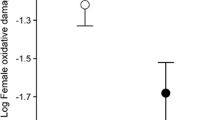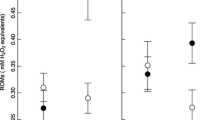Abstract
Antioxidants are powerful protectors against the damaging effects of free radicals that constitute the inevitable by-products of aerobic metabolism. Growing embryos are particularly susceptible to the damaging effects of free radicals produced during rapid growth, and mothers of many species provide protection against such damage by allocating antioxidants to their eggs. Birds living in radioactively contaminated areas use dietary antioxidants to cope with the damaging effects of radiation, but females also allocate dietary antioxidants to eggs, potentially enforcing a physiological trade-off between self-maintenance and reproductive investment. Here we tested whether female great tits Parus major breeding in radioactively contaminated study areas near Chernobyl allocated less dietary antioxidants to eggs, and whether such reduced allocation of dietary antioxidants to eggs had fitness consequences. Concentrations of total yolk carotenoids and vitamins A and E were depressed near Chernobyl compared to concentrations in a less contaminated Ukrainian study area and a French control study area, and all antioxidants showed dose-dependent relationships with all three dietary antioxidants decreasing with increasing level of radiation at nest boxes. These effects held even when controlling statistically for potentially confounding habitat variables and covariation among antioxidants. Laying date was advanced and clutch size increased at nest boxes with high dose rates. Hatching success increased with increasing concentration of vitamin E, implying that hatching success decreased at boxes with high levels of radiation, eventually eliminating and even reversing the higher potential reproductive output associated with early reproduction and large clutch size. These findings are consistent with the hypothesis that radioactive contamination reduced levels of dietary antioxidants in yolks, with negative consequences for hatching success and reproductive success.



Similar content being viewed by others
References
Alonso-Alvarez C, Bertrand S, Devevey G, Prost J, Faivre B, Sorci G (2004) Increased susceptibility to oxidative stress as a proximate cost of reproduction. Ecol Lett 7:363–368
Barja G, Cadenas S, Rojas C, Perez Campo R, Lopes Torres M (1994) Low mitochondrial free radical production per unit of O2 consumption can explain the simultaneous presence of high longevity and high aerobic rate in birds. Free Radic Res 21:317–318
Bazhan KV (1998) Lipid peroxidation and the antioxidant system in subjects exposed to the influence of extreme factors. Lik Sprava 8:47–50
Ben-Amotz A, Yatziv S, Sela M, Greenberg S, Rachmilevich B, Shwarzman M, Weshler Z (1998) Effect of natural beta-carotene supplementation in children exposed to radiation from the Chernobyl accident. Radiat Environ Biophys 37:187–193
Berthold P (2001) Bird migration. Oxford University Press, Oxford
Biard C (2004) Evolutionary ecology of maternal effects mediated by antioxidants in birds. Laboratoire de Parasitologie Evolutive, Université Pierre et Marie Curie, Paris
Biard C, Surai PF, Møller AP (2006) Carotenoid availability in diet and phenotype of blue and great tit nestlings. J Exp Biol 209:1004–1015
Biard C, Surai PF, Møller AP (2007) An analysis of pre- and post-hatching maternal effects mediated by carotenoids in the blue tit. J Evol Biol 20:326–339
Blount JD, Houston DC, Surai PF, Møller AP (2003) Egg-laying capacity is limited by carotenoid pigment availability in wild gulls Larus fuscus. Proc R Soc Lond B (Biol Lett) 271:S79–S81
Chaialo PP, Bereza VI, Chobot’ko GM (1991) Free-radical processes and blood antioxidant systems in the late period following acute radiation sickness. Med Radiol (Moscow) 36:20–21
Clutton-Brock TH (1984) Reproductive effort and terminal investment. Am Nat 123:212–229
Costantini D, Casagrande S, De Filippis S, Brambilla G, Fanfani A, Tagliavini J, Dell’Omo G (2006) Correlates of oxidative stress in wild kestrel nestlings (Falco tinnunculus). J Comp Physiol B 176:329–337
Costantini D, Fanfani A, Dell’Omo G (2007) Carotenoid availability does not limit the capability of nestling kestrels (Falco tinnunculus) to cope with oxidative stress. J Exp Biol 210:1238–1244
Cramp S, Perrins CM (ed) (1988–1993) The birds of the Western Palearctic. vols 5–7, Oxford University Press, Oxford
Halliwell BH, Gutteridge JMC (1999) Free radicals in biology and medicine. 3rd edn. Oxford University Press, Oxford
Holmes DJ, Flückiger R, Austad SN (2001) Comparative biology of aging in birds: an update. Exp Gerontol 36:869–883
Hõrak P, Vellau H, Ots I, Møller AP (2000) Growth conditions affect carotenoid-based plumage coloration of great tit nestlings. Naturwissenschaften 87:460–464
Hõrak P, Surai PF, Møller AP (2002) Fat-soluble antioxidants in the eggs of great tits Parus major in relation to breeding habitat and laying sequence. Avian Sci 2:123–130
Ivaniota L, Dubchak AS, Tyshchenko VK (1998) Free radical oxidation of lipids and antioxidant system of blood in infertile women in a radioactive environment. Ukr Biokhim Zh 70:132–135
Koutsos EA, Clifford AJ, Calvert CC, Klasing KC (2003) Maternal carotenoid status modifies the incorporation of dietary carotenoids into immune tissues of growing chickens (Gallus gallus domesticus). J Nutr 133:1132–1138
Kumerova AO, Lece AG, Skesters AP, Orlikov GA, Seleznev JV, Rainsford KD (2000) Antioxidant defense and trace element imbalance in patients with postradiation syndrome: first report on phase I studies. Biol Trace Elem Res 77:1–12
Leffler JE (1993) An introduction to free radicals. Wiley, New York
Lykholat EA, Chernaya VI (1999) Parameters of peroxidation and proteolysis in the organism of the liquidators of Chernobyl accident consequences. Ukr Biokhim Zh 71:82–85
Møller AP, Mousseau TA (2007a) Birds prefer to breed in sites with low radioactivity in Chernobyl. Proc R Soc Lond B 274:1443–1448
Møller AP, Mousseau TA (2007b) Determinants of interspecific variation in population declines of birds from exposure to radiation at Chernobyl. J Appl Ecol 44:909–919
Møller AP, Biard C, Blount JD, Houston DC, Ninni P, Saino N, Surai PF (2000) Carotenoid-dependant signals: indicators of foraging efficiency, immunocompetence or detoxification ability? Avian Poult Biol Rev 11:137–159
Møller AP, Mousseau TA, Milinevski G, Peklo A, Pysanets E, Szép T (2005a) Condition, reproduction and survival of barn swallows from Chernobyl. J Anim Ecol 74:1102–1111
Møller AP, Surai PF, Mousseau TA (2005b) Antioxidants, radiation and mutation in barn swallows from Chernobyl. Proc R Soc Lond B 272:247–53
Møller AP, Hobson KA, Mousseau TA, Peklo AM (2006) Chernobyl as a population sink for barn swallows: tracking dispersal using stable isotope profiles. Ecol Appl 16:1696–1705
Mousseau TA, Fox CW (eds) (1998) Maternal effects as adaptations. Oxford University Press, Oxford
Neyfakh EA, Alimbekova AI, Ivanenko GF (1998a) Vitamin E and A deficiencies in children correlate with Chernobyl radiation loads of their mothers. Biochemistry (Mosc) 63:1138–1143
Neyfakh EA, Alimbekova AI, Ivanenko GF (1998b) Radiation-induced lipoperoxidative stress in children coupled with deficit of essential antioxidants. Biochemistry (Mosc) 63:977–987
Paradis E, Baillie SR, Sutherland WJ, Gregory RD (1998) Patterns of natal and breeding dispersal in birds. J Anim Ecol 67:518–536
Pärt T, Gustafsson L, Moreno J (1992) Terminal investment and a sexual conflict in the collared flycatcher (Ficedula albicollis). Am Nat 140:868–882
Perrins CM (1979) British tits. Collins, London
Saino N, Ferrari RP, Romano M, Martinelli R, Møller AP (2003) Experimental manipulation of egg carotenoids affects immunity of barn swallow nestlings. Proc R Soc Lond B 270:2485–2489
Shestopalov VM (1996) Atlas of Chernobyl exclusion zone. Ukrainian Academy of Science, Kiev
Surai PF (2000) Effect of selenium and vitamin E content of the maternal diet on the antioxidant system of the yolk and the developing chick. Br Poult Sci 41:235–243
Surai PF (2002) Natural antioxidants in avian nutrition and reproduction. Nottingham University Press, Nottingham
Acknowledgments
We are grateful to S. Gaschak, G. Milinevski, A. M. Peklo, E. Pysanets, I. Chizhevsky, O. Bondarenko, and M. Bondarkov for logistic help during our visits to Ukraine. C. Biard kindly provided information on yolk composition from France. We received funding from the CNRS (France), the University of South Carolina School of the Environment, Bill Murray and the Samuel Freeman Charitable Trust, the Civilian Research Development Foundation, the National Science Foundation and the National Geographic Society to conduct this research.
Author information
Authors and Affiliations
Corresponding author
Additional information
Communicated by G. Heldmaier.
Rights and permissions
About this article
Cite this article
Møller, A.P., Karadas, F. & Mousseau, T.A. Antioxidants in eggs of great tits Parus major from Chernobyl and hatching success. J Comp Physiol B 178, 735–743 (2008). https://doi.org/10.1007/s00360-008-0262-z
Received:
Revised:
Accepted:
Published:
Issue Date:
DOI: https://doi.org/10.1007/s00360-008-0262-z




